Slugs and snails are common pests in hydroponic systems, recognized for their destructive feeding habits on a diverse range of plants and their characteristic slimy trail. Understanding their behavior, life cycle, and effective management strategies is essential for safeguarding your hydroponic garden.
Recognizing Slugs and Snails
These pests are easily identifiable by the irregular holes they create in leaves, stems, and flowers, along with a slimy secretion found on the plants or ground, which is characteristic of their movement.
Life Cycle and Conditions Favoring Growth
Slugs and snails lay eggs in moist conditions and can produce several generations each year, thriving in warm, damp environments. High humidity, excess moisture, and decaying plant matter create ideal conditions for their proliferation. They are most active at night and during wet weather.
Preventive Measures
Preventing slugs and snails requires keeping a clean growing area free of debris, using physical barriers such as copper tape around plant containers, and minimizing excess moisture through better ventilation and drainage.
Treatment Strategies
Effective management involves selectively removing these pests during the night or early morning and setting up beer traps or applying diatomaceous earth around plants.
Home Remedies for Slugs and Snails
1. Beer Traps
-
Instructions: Use shallow containers, bury them so the rim is at ground level, fill with beer to attract slugs and snails, check and refresh the traps regularly, and place near affected areas for best results.
2. Diatomaceous Earth
-
Instructions: Use food-grade diatomaceous earth for safety, apply it around the base of plants to create a barrier, and reapply after watering or rain since it loses effectiveness when wet. The sharp edges deter slugs and snails by causing physical harm to them as they attempt to cross.
Monitoring and Maintenance
Regular inspections for slugs and snails, particularly after dark, along with maintaining cleanliness and optimal moisture levels, are essential for managing these pests. The reapplication of deterrents and physical removal should be included in an integrated pest management approach.
Integrated Pest Management
While beer traps and diatomaceous earth can effectively control slugs and snails, combining these methods with regular maintenance, environmental control, and manual removal will offer the best protection for your hydroponic garden. Ensuring the health of your plants and the cleanliness of your growing environment is essential in preventing infestations and maintaining a productive hydroponic system.




